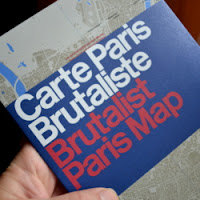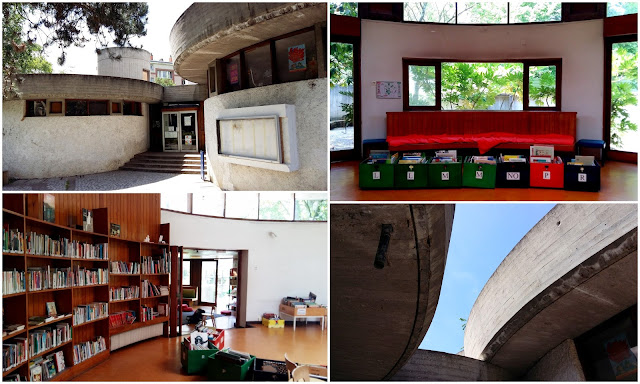Paris and concrete goes back a long way. As we have already seen on Invisible Paris, one of the pioneers of reinforced concrete, François Hennebique, housed his Paris offices in one the first buildings in the world to be constructed using only this material (which he also used to create his own mad home). His techniques would later be adopted in the city by architects such as Auguste Perret, Pierre Patout and most famously of all, Le Corbusier.
So why is Paris not a concrete city? In many ways it is, but almost exclusively in its edges and outskirts. The centre of Paris was spared the post-war rebuild that many other European cities had to undertake, but a huge increase in population - mostly in mushrooming suburbs and new satellite towns - meant that new builds were necessary across the whole region. Much of this construction was limited to poor-quality tower blocks that were also scuppered by disasterous planning and a desparate lack of infrastructure, but some gems have survived and merit celebration.
This is the goal of the Brutalist Paris Map’s creator, Robin Wilson, a professor in Architecture and Built Environment, who also points out the movement's French roots, with the term ‘new brutalism’ - which defined a (very loose) style - taking its inspiration from the French term 'beton brut' (raw concrete).
Wilson's choices are all post-war, covering "the moment of transition between modernism and post-modernism", and are unsuprisingly mostly "beyond the Periphérique." Although the city's early concrete pioneers were able to build theatres and museums, this 'brutalist' period is principally housing, offices and administrative constructions, but many are most definitely worth the trip out of the city.
There is perhaps irony in the fact that some of these are so out of the way that they only feature on the map as arrows, but providing clear and detailed access information does not seem to be the objective of this publication. Instead we have a handsome object, equally pleasant to the hand and eye, full of inspiration and with a nice selection of photos from Nigel Green on the reverse side.
Buy the map at Blue Crow Media (several other cities are also available), or with a little bit of luck at one of your local stockists!
Some concrete examples
With the map in hand, I took the opportunity to rediscover a few of my concrete favourites:La Petite Bibliotheque Ronde (Clamart)
Atelier de Montrouge (Jean Renaudie, Pierre Riboulet, Gérard Thurnauer, Jean-Louis Véret, 1965)
This children's library, all in curves, is an enchanting building implanted in the centre of a very successful 1950s housing estate (Cité de la Plaine). Despite being a listed building, it is currently surrounded by 3 metre high fences, supposedly ahead of renovation but more tellingly as a visible sign of conflict between the administrators of the library and the Clamart town council. The building was a private initiative, paid for by Anne Schlumberger, daughter of a wealthy French industrialist, and has always played a central role in the community with little or no assistance from the local authorities.
Passing by recently, I was invited inside by one of the employees who also gave me a guided tour of the building. He explained that the library remains in danger (find out more here (in French)), but that nevertheless there was confidence that the future was bright for the building. Bright is also the right word for a library that lets in natural light from all directions and which seems at one with the nature outside.
Regular tours of the library are organised (TARDIS like, it has several spacious rooms and levels, and also includes furniture and fittings by Alvar Aalto). More details on the association's website.
Cimitière inter-communal (Clamart)
Robert Auzelle, Ivan Jankovic, 1956
Just a few hundred metres from the Petite Bibliotheque Ronde is another charming and remarkable location. Yes, this is a cemetery, but it is unlike any other I know in the Paris region. Instead of being a gloomily gothic sculpture park, it is more like a public garden and surprisingly full of life! The 'brutalist' part is centred on a light and airy entrance, which also discreetely houses the cemetery's functional elements, and manages at once to be both sculpted and simple.
Beyond this is a vast green space, with most of the graves and tombs spreading out under the shade of the Meudon forest. To one side is a large sporting facility, with access through these concrete gates and across part of the cemetery. This means that there is a regular flow of children and families and brings the cemetery into the centre of the community. Brutalism hasn't always been linked with successful town planning, but this is a fine example.
Le Central Téléphonique Murat
Pierre Vivien, 1970
Apparently still belonging to a branch of the French national telecommunications network, the entrance gates are firmly locked and weeds are pushing through cracks in the concrete. The cylindrical 'watchtower' is said to be just the visible head and neck of a much larger underground structure - which may or may not still be in use!
Les Damiers (Courbevoie/La Défense)
Michel Folliasson, 1974-76
If you want concrete, La Défense is probably the place to go, even if most tall structures are now covered with reflective glass. There is the soaring CNIT building of course, perhaps surprisingly overlooked for this map, and the Vision 80 and nearby Pablo Picasso (nuage) buldings in Nanterre, which do feature in this publication.
Closest of all to Paris though is the somewhat nebulous and sprawling 'Damiers' estate, part of which has been slated for demolition for over 10 years. It would be difficult to describe any of it as attractive, with the Meccano-style constructions being far too heavy and vaguely dystopian. What it does have though is a certain drama, with a series of unexpected and destabilising angles, stairways, corridors and floor levels.
Perhaps more importantly, it has the merit of squatting alongside the headquarters buildings of the country's richest companies. In one of Europe's largest financial districts, it is an amusing and unseemly slap of egalitarianism!




















3 comments:
ㅁㄴㅇㄹㅁㄴㅇㄹ
index:obathammer.id
index:obatkuatcialis.id
index:jualmaxman.com
index:obathammerofthor.id
Thanks for sharing
Post a Comment